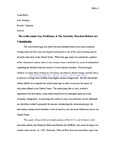The Achievement Gap, Proficiency & The Kentucky Education Reform Act

View/
Author
Milby, James G.
Subject
Washington and Lee University, Shepherd Poverty Program
Education Reform Act (Kentucky : 1990)
Education -- Evaluation
School districts -- Finance
Competency-based education
Kentucky Instructional Results Information System
Metadata
Show full item recordDescription
James G. Milby is a member of the Class of 2008 of Washington and Lee University. Capstone; [FULL-TEXT FREELY AVAILABLE ONLINE] This paper will provide an in-depth analysis of the U.S.'s most extensive state education reform, the Kentucky Education Reform Act (KERA), and assess its impact on student achievement. In a 1991 Kentucky Office of Education Accountability report, the state elucidates its intentions for education in Kentucky. The report emphatically states, “The children of the poor and the children of the rich, the children who live in the poor district and the children who live in the rich district must be given the same opportunity and access to an adequate education” (OEA , December 1991:1). Nearly 18 years after KERA's implementation, this paper will gauge the success of the act's curriculum, accountability, and governance reforms in reducing the achievement gap in the state and providing access to “adequate education”. The analysis of the state's accountability test scores (KIRIS and CATS), national test scores (ACT, NAEP), and other, non-standardized measures of school district performance (drop-out rates, graduation rates, college attendance) will show that KERA has not produced its desired results. [From Introduction] Grant Milby